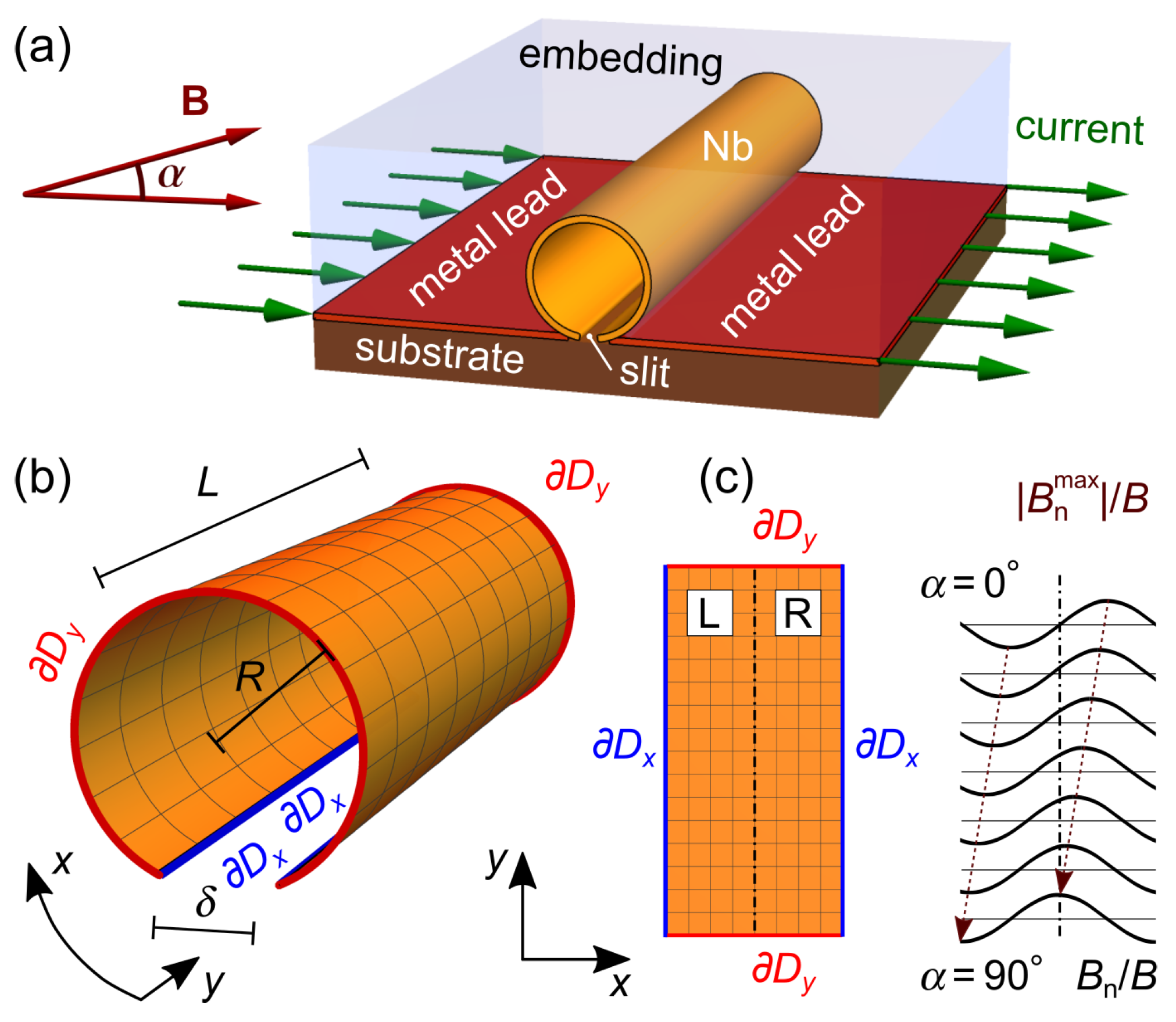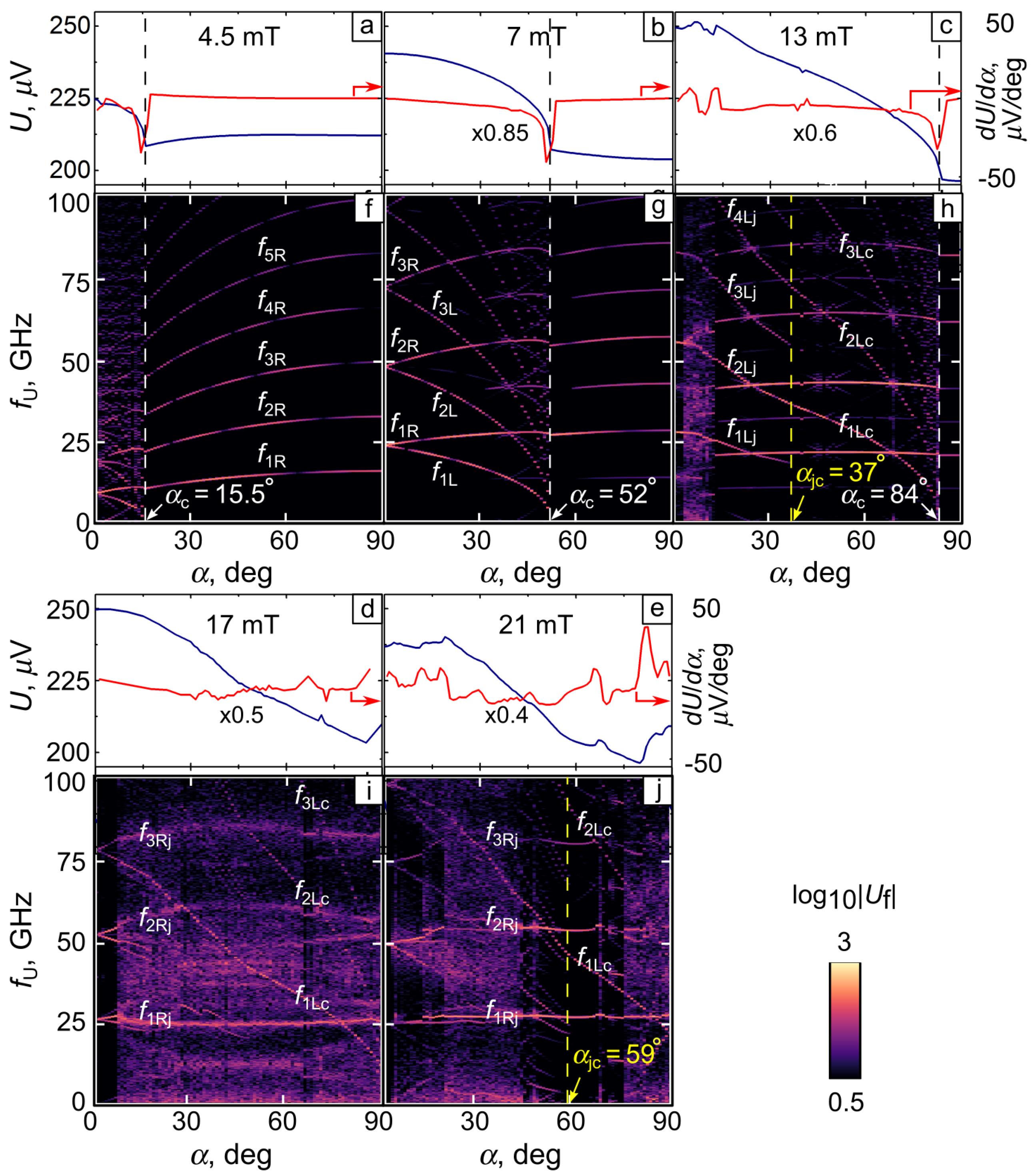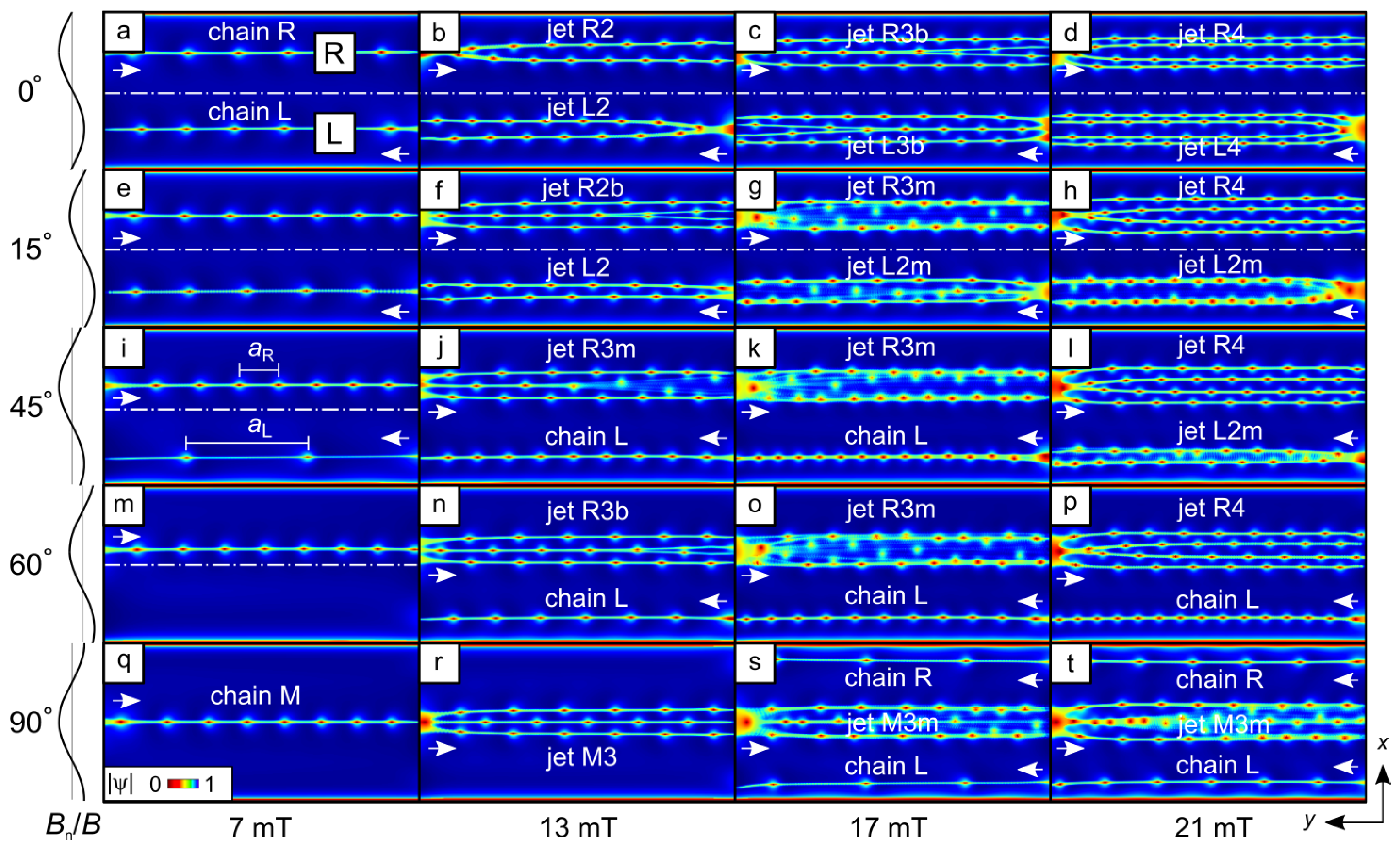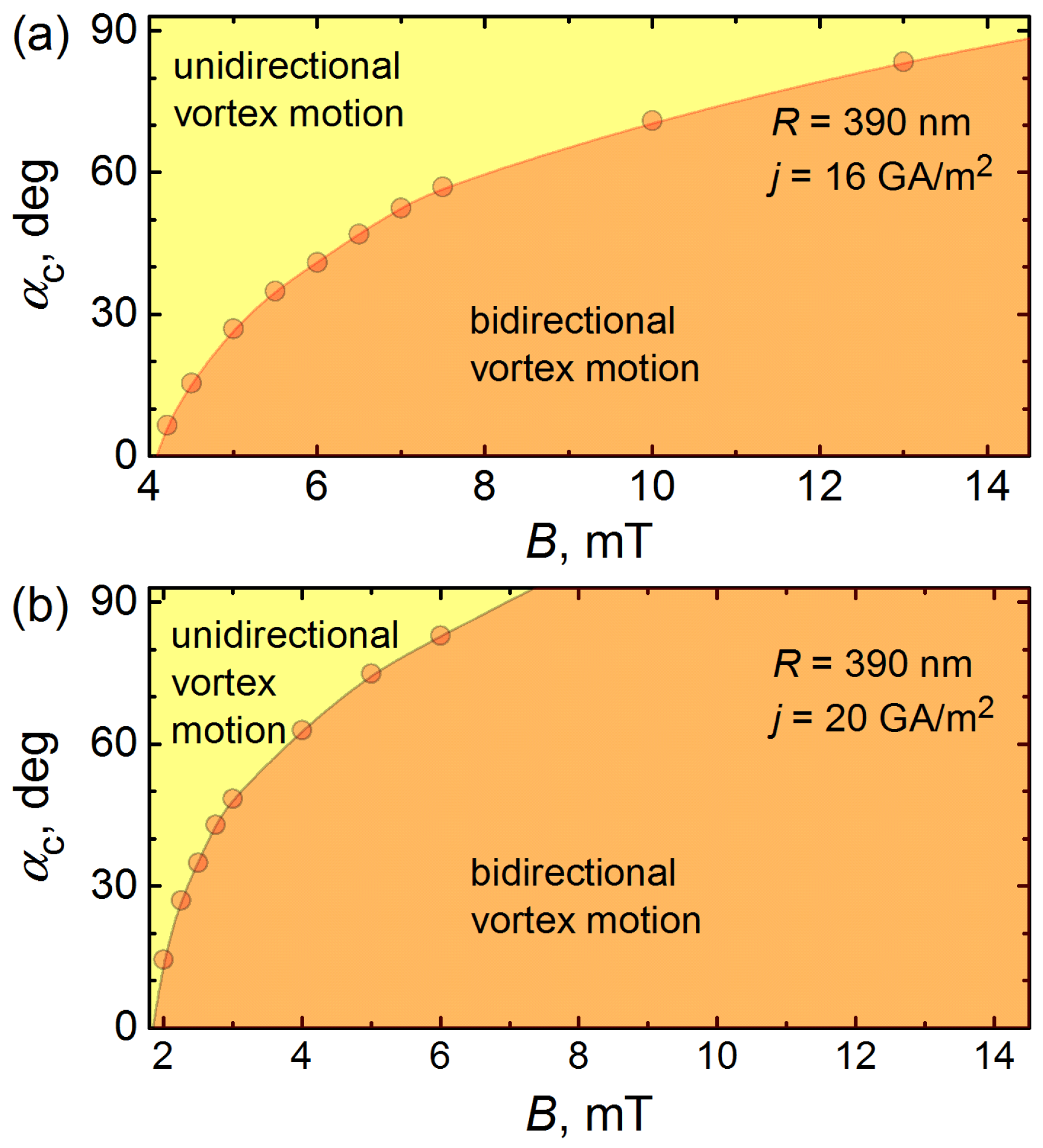Steering of Vortices by Magnetic Field Tilting in Open Superconductor Nanotubes
Abstract
:1. Introduction
2. Results
3. Methods
4. Discussion
5. Conclusions
Author Contributions
Funding
Data Availability Statement
Conflicts of Interest
References
- Brandt, E.H. The flux-line lattice in superconductors. Rep. Progr. Phys. 1995, 58, 1465. [Google Scholar] [CrossRef]
- Reichhardt, C.; Olson, C.J.; Nori, F. Dynamic Phases of Vortices in Superconductors with Periodic Pinning. Phys. Rev. Lett. 1997, 78, 2648–2651. [Google Scholar] [CrossRef]
- Guillamón, I.; Suderow, H.; Fernández-Pacheco, A.; Sesé, J.; Córdoba, R.; De Teresa, J.M.; Ibarra, M.R.; Vieira, S. Direct observation of melting in a two-dimensional superconducting vortex lattice. Nat. Phys. 2009, 5, 651–655. [Google Scholar] [CrossRef]
- Silhanek, A.V.; Milošević, M.V.; Kramer, R.B.G.; Berdiyorov, G.R.; Van de Vondel, J.; Luccas, R.F.; Puig, T.; Peeters, F.M.; Moshchalkov, V.V. Formation of Stripelike Flux Patterns Obtained by Freezing Kinematic Vortices in a Superconducting Pb Film. Phys. Rev. Lett. 2010, 104, 017001. [Google Scholar] [CrossRef] [PubMed]
- Cerbu, D.; Gladilin, V.N.; Cuppens, J.; Fritzsche, J.; Tempere, J.; Devreese, J.T.; Moshchalkov, V.V.; Silhanek, A.V.; Van de Vondel, J. Vortex ratchet induced by controlled edge roughness. New J. Phys. 2013, 15, 063022. [Google Scholar]
- Vodolazov, D.Y.; Ilin, K.; Merker, M.; Siegel, M. Defect-controlled vortex generation in current-carrying narrow superconducting strips. Supercond. Sci. Technol. 2015, 29, 025002. [Google Scholar] [CrossRef]
- Clem, J.R.; Berggren, K.K. Geometry-dependent critical currents in superconducting nanocircuits. Phys. Rev. B 2011, 84, 174510. [Google Scholar] [CrossRef]
- Adami, O.A.; Cerbu, D.; Cabosart, D.; Motta, M.; Cuppens, J.; Ortiz, W.A.; Moshchalkov, V.V.; Hackens, B.; Delamare, R.; Van de Vondel, J.; et al. Current crowding effects in superconducting corner-shaped Al microstrips. Appl. Phys. Lett. 2013, 102, 052603. [Google Scholar] [CrossRef]
- Embon, L.; Anahory, Y.; Jelic, Z.L.; Lachman, E.O.; Myasoedov, Y.; Huber, M.E.; Mikitik, G.P.; Silhanek, A.V.; Milosevic, M.V.; Gurevich, A.; et al. Imaging of super-fast dynamics and flow instabilities of superconducting vortices. Nat. Commun. 2017, 8, 85. [Google Scholar] [CrossRef]
- Friesen, M.; Gurevich, A. Nonlinear current flow in superconductors with restricted geometries. Phys. Rev. B 2001, 63, 064521. [Google Scholar] [CrossRef]
- Ustavschikov, S.S.; Levichev, M.Y.; Pashenkin, I.Y.; Gusev, N.S.; Gusev, S.A.; Vodolazov, D.Y. Negative differential resistance and Shapiro steps in superconducting MoN strip with slit. JETP Lett. 2022, 135, 226. [Google Scholar] [CrossRef]
- Aladyshkin, A.; Mel’nikov, A.S.; Shereshevsky, I.A.; Tokman, I.D. What is the best gate for vortex entry into type-II superconductor? Phys. C 2001, 361, 67. [Google Scholar] [CrossRef]
- Bezuglyj, A.I.; Shklovskij, V.A.; Budinská, B.; Aichner, B.; Bevz, V.M.; Mikhailov, M.Y.; Vodolazov, D.Y.; Lang, W.; Dobrovolskiy, O.V. Vortex jets generated by edge defects in current-carrying superconductor thin strips. Phys. Rev. B 2022, 105, 214507. [Google Scholar] [CrossRef]
- Meservey, R.; Meyers, L. Phase Transition of Thin-Film Superconducting Cylinders in a Magnetic Field. II. Angular Dependence. Phys. Rev. B 1972, 6, 2632–2642. [Google Scholar] [CrossRef]
- Yeo, J.; Moore, M.A. Noninteger flux quanta for a spherical superconductor. Phys. Rev. B 1998, 57, 10785–10789. [Google Scholar] [CrossRef]
- Du, Q.; Ju, L. Numerical simulations of the quantized vortices on a thin superconducting hollow sphere. J. Comput. Phys. 2004, 201, 511–530. [Google Scholar] [CrossRef]
- Hayashi, M.; Ebisawa, H.; Kuboki, K. Superconductivity on a Möbius strip: Numerical studies of order parameter and quasiparticles. Phys. Rev. B 2005, 72, 024505. [Google Scholar] [CrossRef]
- de Romaguera, A.R.C.; Doria, M.M.; Peeters, F.M. Transverse magnetization and torque in asymmetrical mesoscopic superconductors. Phys. Rev. B 2007, 76, 020505. [Google Scholar] [CrossRef]
- Xu, B.; Milošević, M.V.; Peeters, F.M. Magnetic properties of vortex states in spherical superconductors. Phys. Rev. B 2008, 77, 144509. [Google Scholar] [CrossRef]
- Tempere, J.; Gladilin, V.N.; Silvera, I.F.; Devreese, J.T.; Moshchalkov, V.V. Coexistence of the Meissner and vortex states on a nanoscale superconducting spherical shell. Phys. Rev. B 2009, 79, 134516. [Google Scholar] [CrossRef]
- Qiu, C.; Qian, T. Numerical study of the phase slips in ultrathin doubly connected superconducting cylinders. Phys. Rev. B 2009, 79, 054513. [Google Scholar] [CrossRef]
- Mawatari, Y. Field distributions in curved superconducting tapes conforming to a cylinder carrying transport currents. Phys. Rev. B 2009, 80, 184508. [Google Scholar] [CrossRef]
- Sabatino, P.; Carapella, G.; Costabile, G. Magneto-transport properties of curved mesoscopic superconducting strips. Supercond. Sci. Technol. 2011, 24, 125007. [Google Scholar] [CrossRef]
- Gladilin, V.N.; Tempere, J.; Devreese, J.T.; Moshchalkov, V.V. Aharonov-Bohm oscillations in the vortex dynamics in superconducting hollow cylinders. Phys. Rev. B 2012, 86, 104508. [Google Scholar] [CrossRef]
- Gladilin, V.; Tempere, J.; Devreese, J.; Moshchalkov, V. Negative-μ regime in the ac magnetic response of superconductor nanoshells. Sol. Stat. Commun. 2012, 152, 1781–1785. [Google Scholar] [CrossRef]
- Qin, F.; Shi, W.; Ideue, T.; Yoshida, M.; Zak, A.; Tenne, R.; Kikitsu, T.; Inoue, D.; Hashizume, D.; Iwasa, Y. Superconductivity in a chiral nanotube. Nat. Commun. 2017, 8, 14465. [Google Scholar] [CrossRef] [PubMed]
- Kvorning, T.; Hansson, T.H.; Quelle, A.; Smith, C.M. Proposed Spontaneous Generation of Magnetic Fields by Curved Layers of a Chiral Superconductor. Phys. Rev. Lett. 2018, 120, 217002. [Google Scholar] [CrossRef]
- Bogusch, I.; Dobrovolskiy, O.V.; Fomin, V.M. Microwave generation and vortex jets in superconductor nanotubes. arXiv 2023, arXiv:2311.02946. [Google Scholar]
- Fomin, V.M.; Rezaev, R.O.; Dobrovolskiy, O.V. Topological transitions in ac/dc-driven superconductor nanotubes. Sci. Rep. 2022, 12, 10069. [Google Scholar] [CrossRef]
- Bogush, I.; Fomin, V.M. Topological defects in open superconducting nanotubes after gradual and abrupt switching of the transport current and magnetic field. Phys. Rev. B 2022, 105, 094511. [Google Scholar] [CrossRef]
- Thurmer, D.J.; Deneke, C.; Schmidt, O.G. In situ monitoring of the complex rolling behaviour of InGaAs/GaAs/Nb hybrid microtubes. J. Phys. D Appl. Phys. 2008, 41, 205419. [Google Scholar] [CrossRef]
- Thurmer, D.J.; Bufon, C.C.B.; Deneke, C.; Schmidt, O.G. Nanomembrane-Based Mesoscopic Superconducting Hybrid Junctions. Nano Lett. 2010, 10, 3704–3709. [Google Scholar] [CrossRef] [PubMed]
- Lösch, S.; Alfonsov, A.; Dobrovolskiy, O.V.; Keil, R.; Engemaier, V.; Baunack, S.; Li, G.; Schmidt, O.G.; Bürger, D. Microwave Radiation Detection with an Ultra-Thin Free-Standing Superconducting Niobium Nanohelix. ACS Nano 2019, 13, 2948. [Google Scholar] [CrossRef] [PubMed]
- Grimaldi, G.; Leo, A.; Avitabile, F.; Martucciello, N.; Galluzzi, A.; Polichetti, M.; Pace, S.; Nigro, A. Vortex lattice instability at the nanoscale in a parallel magnetic field. Nanotechnology 2019, 30, 424001. [Google Scholar] [CrossRef]
- Peroz, C.; Villard, C. Flux flow properties of niobium thin films in clean and dirty superconducting limits. Phys. Rev. B 2005, 72, 014515. [Google Scholar] [CrossRef]
- Ferrari, G.; Cuoghi, G. Schrödinger Equation for a Particle on a Curved Surface in an Electric and Magnetic Field. Phys. Rev. Lett. 2008, 100, 230403. [Google Scholar] [CrossRef]
- Thinkham, M. Introduction to Superconductivity; McGraw Hill: New York, NY, USA, 1996. [Google Scholar]
- Sadovskyy, I.A.; Koshelev, A.E.; Phillips, C.L.; Karpeyev, D.A.; Glatz, A. Stable large-scale solver for Ginzburg–Landau equations for superconductors. J. Comp. Phys. 2015, 294, 639. [Google Scholar] [CrossRef]
- Kato, R.; Enomoto, Y.; Maekawa, S. Effects of the surface boundary on the magnetization process in type-II superconductors. Phys. Rev. B 1993, 47, 8016. [Google Scholar] [CrossRef]
- Mayadas, A.F.; Laibowitz, R.B.; Cuomo, J.J. Electrical characteristics of rf-sputtered single-crystal niobium films. J. Appl. Phys. 1972, 43, 1287. [Google Scholar] [CrossRef]
- Olson, C.J.; Reichhardt, C.; Nori, F. Superconducting vortex avalanches, voltage bursts, and vortex plastic flow: Effect of the microscopic pinning landscape on the macroscopic properties. Phys. Rev. B 1997, 56, 6175–6194. [Google Scholar] [CrossRef]
- Glatz, A.; Vlasko-Vlasov, V.K.; Kwok, W.K.; Crabtree, G.W. Vortex cutting in superconductors. Phys. Rev. B 2016, 94, 064505. [Google Scholar] [CrossRef]
- Velez, M.; Martin, J.I.; Villegas, J.E.; Hoffmann, A.; Gonzalez, E.M.; Vicent, J.L.; Schuller, I.K. Superconducting vortex pinning with artificial magnetic nanostructures. J. Magn. Magnet. Mat. 2008, 320, 2547–2562. [Google Scholar] [CrossRef]
- Staas, F.A.; Niessen, A.K.; Druyvesteyn, W.F.; Suchtelen, J.V. Guided motion of vortices in type II superconductors. Phys. Lett. 1964, 13, 293–295. [Google Scholar] [CrossRef]
- Dobrovolskiy, O.V.; Huth, M.; Shklovskij, V.A. Anisotropic magnetoresistive response in thin Nb films decorated by an array of Co stripes. Supercond. Sci. Technol. 2010, 23, 125014. [Google Scholar] [CrossRef]
- Silhanek, A.V.; Van de Vondel, J.; Moshchalkov, V.V. Guided Vortex Motion and Vortex Ratchets in Nanostructured Superconductors. In Nanoscience and Engineering in Superconductivity; Springer: Berlin/Heidelberg, Germany, 2010; pp. 1–24. [Google Scholar]
- Shklovskij, V.A.; Sosedkin, V.V.; Dobrovolskiy, O.V. Vortex ratchet reversal in an asymmetric washboard pinning potential subject to combined dc and ac stimuli. J. Phys. Cond. Matt. 2014, 26, 025703. [Google Scholar] [CrossRef] [PubMed]




| Parameter | Unit | Value of Nb at |
|---|---|---|
| Time | 2.8 ps | |
| Length | 60 nm | |
| Magnetic field | 92 mT | |
| Current density | 60 GA | |
| Electric potential | 111 µV | |
| Conductivity | 31 (µ |
| Parameter | Denotation | Value for Nb |
|---|---|---|
| Electron mean free path | l | 6 nm |
| Fermi velocity | 600 km/s | |
| Diffusion coefficient | 12 cm2/s | |
| Normal conductivity [35,40] | 16 (µ | |
| Relative temperature | 0.952 | |
| Penetration depth | 278 nm | |
| Coherence length | 60 nm | |
| GL parameter | 4.7 |
Disclaimer/Publisher’s Note: The statements, opinions and data contained in all publications are solely those of the individual author(s) and contributor(s) and not of MDPI and/or the editor(s). MDPI and/or the editor(s) disclaim responsibility for any injury to people or property resulting from any ideas, methods, instructions or products referred to in the content. |
© 2024 by the authors. Licensee MDPI, Basel, Switzerland. This article is an open access article distributed under the terms and conditions of the Creative Commons Attribution (CC BY) license (https://creativecommons.org/licenses/by/4.0/).
Share and Cite
Bogush, I.; Fomin, V.M.; Dobrovolskiy, O.V. Steering of Vortices by Magnetic Field Tilting in Open Superconductor Nanotubes. Nanomaterials 2024, 14, 420. https://doi.org/10.3390/nano14050420
Bogush I, Fomin VM, Dobrovolskiy OV. Steering of Vortices by Magnetic Field Tilting in Open Superconductor Nanotubes. Nanomaterials. 2024; 14(5):420. https://doi.org/10.3390/nano14050420
Chicago/Turabian StyleBogush, Igor, Vladimir M. Fomin, and Oleksandr V. Dobrovolskiy. 2024. "Steering of Vortices by Magnetic Field Tilting in Open Superconductor Nanotubes" Nanomaterials 14, no. 5: 420. https://doi.org/10.3390/nano14050420






